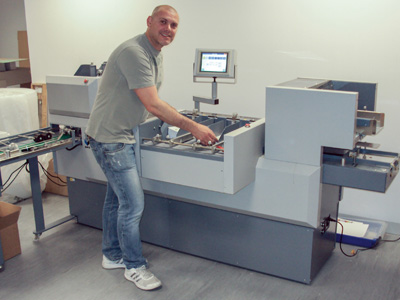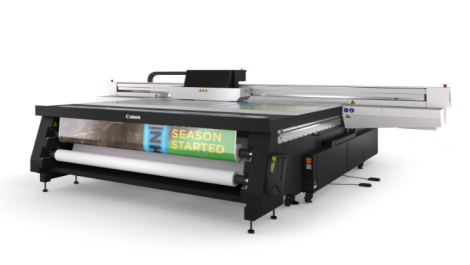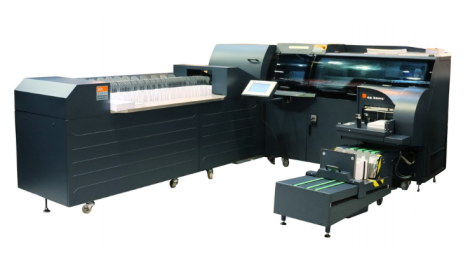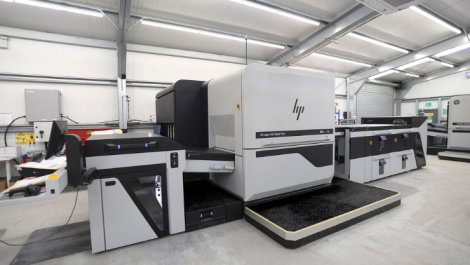Steve Walter, director at Hartgraph in Amsersham, with his recently installed Mailmaster C4 Compact from KAS Paper Systems.
Bringing mail services inhouse can be a cost-effective way for digital printers to expand their business. Simon Eccles looks at some of the routes to get there.
If you are spending a fortune on outsourcing mailing work to outside specialists, could you make a saving by bringing the work inhouse? That is a question increasingly occurring to some small to medium sized digital print houses.
‘Falling margins in print is making printers look for added value by offering an all-in-one and internal solution, including services such as direct mail,’ said Steve Jarvis, sales manager at KAS Paper Systems. With the culling in the print industry creating less over-capacity, those that have survived are looking to invest in ways to expand. Personalised direct mail is a natural expansion for digital printers, particularly where it is combined with added-value, multi-channel marketing communication. The other growth area seems to be in hybrid mail, in both the private and public sectors, where organisations outsource the printing and mailing of letters to a third party, such as a printer or mailing house, which passes on the cost benefits of high-volume printing and postage.
‘The days of simply putting ink or toner on paper, folding it, stuffing it into an envelope and mailing this to all and sundry, are long gone,’ said Mr Jarvis. ‘The growth is in personalised covering letters, inserts and envelopes, with eye-catching and bespoke designs and colours, data manipulation and creating added value and a feeling in the recipient that someone has made an effort to attract their attention, not just composed one email to thousands of prospects and pressed send.’
Full colour envelopes
Envelope printing is progressing in step with digital document printing. Even if you do not have a digital press or use variable data on the inserts, a digital envelope printer can add sophistication and direct communication to the part the targeted recipient sees first. There are plenty of these around, often based on the tough and versatile OKI range of compact toner printers. However, faster inkjets are starting to come through.
For instance the AMS M1 colour inkjet printer from Addressing & Mailing Solutions (AMS) is very compact with a footprint of 610 x 500 mm, but goes at a considerable lick thanks to Memjet inkjet single-pass technology. Costing around £11,000, it can print up to 9000 envelopes per hour in full colour, or 3600 A4 flat sheets. Optional Flexmail software can set up the variable data. ‘It enables printers and mailing houses to print colour at high speed and low cost for personalised mailings and variable data printing,’ said Victoria Christen, marketing manager at AMS.
Originally, envelope printers were monochrome and just needed to handle addresses, she continued. ‘Over recent years AMS has seen a huge demand for equipment and software that can print variable data and images accurately. A growth area is the need to digitally print quality PPIs (Postage Paid Impressions) such as the Royal Mail’s Mailmark. Our M1 envelope printer is perfect for this. The Royal Mail is also trialling a new full-colour digital stamp indicia which is likely to be rolled out UK-wide next year.’
These trial digital stamp designs look like conventional full-colour self-adhesive stamps with cancellation marks, but are printed onto the envelopes. The initial trial, organised by Royal Mail Wholesale, ran from September to the end of November.
You would need a relatively upmarket envelope inserting line to keep up with the M1’s 9000 per hour. However, many small mail runs are not going to need that sort of capacity all through a typical day, so a relatively slow system would be enough. For instance, the AMS 6500, 7100 and 7500 folder-inserters can be configured with up to three inserting stations for speeds up to 3500 envelopes per hour. With a price of £17,000 for a 7500 and footprint of 454 x 1300 mm, you could have several of these for the price of one high capacity line.
Neopost is also a big supplier into the mailing market. Its range of inserters is basically the same as AMS offers, but with different names. It offers the AS-970C Mach 5 full-colour Memjet-based envelope/document printers, with dedicated feeders and optional conveyor-stackers. It also has black-only HP based printers that go faster (up to 14,000 envelopes per hour) with optional spot colour cartridges. Its fastest printer, AS-960, can print a healthy 26,000 DL envelopes or 39,000 postcards per hour, with up to six spot colours. Neopost puts a lot of emphasis on software, aimed at everything from small mailrooms up to full time mail houses. It is big on document generation, management and tracking, and has also developed interesting cross-media mailing apps.
Names like Bell + Howell, Buhrs, CMC, Kern and Pitney Bowes are long established in mailing, with all of them offering solutions suitable for relatively modest runs up to huge high capacity lines for full-time mail houses. For instance, a Bell + Howell Forerunner system can handle up to 13,000 mail pieces per hour with up to 16 stations. This uses gripper arm feed, with optional friction rollers. CMC offers the entry level 150 inserter with six to eight stations, handling all common envelope sizes at up to 9000 pieces per hour. Pitney Bowes’ 16,000 piece per hour DPS100 line is another good starter system according to ProMail, which sells it in the UK.
Economic arguments
KAS Paper Systems offers equipment for envelopes and polywrapping. These range from entry level C4/C5/DL envelope inserters with a small footprint, up to high speed, intelligent machines for transactional mailing with barcode camera reading and insert matching for marketing and financial mailings.
The entry level KAS Mailmaster Compact encloses up to four inserts into C4, C5 and DL at up to 5000 envelopes per hour. ‘It costs about £40,000, which spread over five years is about £800 per month, points out Mr Jarvis. ‘When I give these figures to printers, a lot will say “I’m spending over £1,000 per month on mailing houses. Often it’s justifiable for printers who hand-enclose or outsource as little as two or three mailings per month. A basic Compact can be expanded later with an intelligent sheet feeder/collator/folder, with barcode reading for transactional mailings.’
Refurbished alternative
Mail insertion lines tend to be robustly built and a good one can easily last a decade or more. So it makes sense, said Daran Hanson at Promail, to consider a refurbished line that has perhaps been brought up to date with modern barcode readers, inkjet printers and the like. ‘Historically printers trying their hand at mailing went for something very cheap to make do with. But increasingly they see mailing as a big value-add to their business. Keeping it in-house means it’s more secure, more professional and their clients are demanding a one-stop service now.
‘We go into the client to see what they are likely to need in the future. It may be non-intelligent to start with but they may want to add cameras and inkjets at a later date. They may want full read and print systems inline eventually. Everything we sell new is scalable and it might be added to later.
‘It’s the same with refurbished equipment, which may not need a full rebuild, but we will make it mechanically right and also cosmetically agreeable. What clients often look for is something that will do for now but they can grow with over the next several years. But obviously there’s a big saving to be made on used fully-refurbished equipment. You may be saving 50 or 60% compared with brand new.’
One piece mailers
Mailing does not have to involve separate envelopes. One-piece mailers remain popular for some types of communication. Encore sells a versatile Pit Stop/MB Digital line that offers an automatically set one-piece mailing solution, said Peter Davidson, Encore’s sales manager.
‘It’s a fully automated rise and fall folding system with the ability to put a mailing solution on the end, for anything from attaching cards to plough folding, tipping-on, three-side sealing. There are many different solutions and no two are the same.’
MB Bäuerle offers its own high end inserters with speeds around 23,000 pieces per hour, but they cost from £200,000, said Mr Davidson. A lower cost option is to add an MB automated accumulating folder to an existing or refurbished insertion line. ‘This can take up to eight sheets and fold them together to C5 or DL and that can go onto the inserting line. We’ve worked with other manufacturers, including some very good refurbished systems from CMC in Wellingborough, that work well. You can put a new accumulating folder and some cameras on an older inserter, which lets them do selective insertion.’
Preformed sheets
For more occasional one-piece mailer work, or for trying out the market, pre-formed printable sheets are an interesting option. For instance Convertible Solutions is a Germany-based supplier of blank pre-formed items called Fold ‘N Go, distributed by Premier Paper in the UK. The sheets are pre-scored, with cohesive (pressure-sensitive) or remoist glue pre-applied, and with pre-printed guide marks. Downloadable design templates let you set up artwork around the glue positions.
These can run on most digital presses. The range includes a ready-scored mailer with ready-applied remoist glue to form a reply envelope. There are sheets with pre-perfed press-out cards for loyalty schemes and the like, a folding A4 mailer with five pull-up tabs that can reveal offers or prizes, a self-mailer with pre-perfed coupons at the bottom, and double-thick mailer with a large pull-up reveal panel that can again show a prize or offer.
Unless you are certain that mailing is going to be a major self-supporting part of your business, it is best to start small and carefully and choose systems that complement what you have got and can be expanded as the business warrants it. As Ms Christen at AMS points out: ‘By adopting a strategic approach to postal mailing processes, it can be straightforward. With an entry level mail folder, inserter and envelope printer, you are good to go. However, clients need to be able to trust their printer with the data, so it is advisable to start by offering a new mailing service to existing clients, where a level of trust should already be there.’





